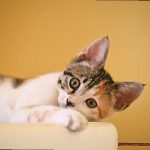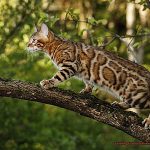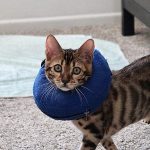Cats are curious creatures, always on the hunt for new and exciting things to explore. As a cat owner, you may want to switch up your feline friend’s diet by introducing different types of food. However, sometimes cats can get into things they shouldn’t be eating, like turtle food.
While it’s unlikely that your cat will go out of its way to chow down on turtle food, accidents happen. If your cat does eat turtle food, it can lead to various health complications. Turtle food is specifically designed to meet the nutritional needs of turtles and contains high levels of protein – something that is essential for turtles but not so much for our feline friends.
If your cat eats too much turtle food, it can cause an imbalance in their diet and lead to digestive discomfort. Symptoms such as vomiting, diarrhea, and constipation are all possible side-effects. In severe cases, eating turtle food can even cause liver or kidney damage.
It’s important to remember that cats have different nutritional needs than turtles do. Feeding them the wrong type of food can have adverse effects on their health. That’s why keeping these two foods separate is crucial.
In this post, we’ll take a closer look at what happens when a cat eats turtle food and why it’s essential to pay attention to what our pets are eating. So let’s dive in.
What Are the Nutritional Needs of Cats?
Cats are obligate carnivores, meaning they require a diet primarily composed of animal protein and fats. It is crucial to provide them with the right amount of nutrients to avoid potential health problems such as obesity, diabetes, urinary tract disease, and dental issues.
Amino acids and essential nutrients are vital to a cat’s overall health. Unlike other animals, cats cannot synthesize taurine, an essential amino acid, and must obtain it from their diet. They also require certain vitamins and minerals like vitamin A, niacin, calcium, and phosphorus in specific amounts.
Commercial cat food is formulated to meet the nutritional requirements of cats and is available in wet and dry forms. Wet cat food contains more moisture than dry food, which can help prevent dehydration in cats. The texture and flavor of wet cat food are also more palatable to cats. However, dry cat food is more convenient to store and can help promote dental health by reducing plaque buildup.
Owners should avoid feeding their cats human food as it may not meet their nutritional requirements. Additionally, some foods like onions, garlic, chocolate, and grapes can be toxic to cats. It is essential to consult with a veterinarian before making any significant changes to a cat’s diet or feeding them anything new.
A lack of proper nutrition can lead to health problems like obesity, diabetes, urinary tract disease, and dental issues. Providing your cat with a balanced diet that meets their nutritional needs is crucial for their overall health and well-being.
What Is in Turtle Food?
Turtle food is the answer. Specially formulated to meet the dietary needs of turtles, this reptilian cuisine is packed with a variety of nutrients that are essential for their overall health and wellbeing.
Let’s take a closer look at what’s inside turtle food. First up, protein. Just like humans need protein to build and repair muscles, turtles require it too. Most commercial turtle foods contain sources of protein, such as fish, shrimp, krill, and insects. Some may even contain plant-based proteins like soybean meal or wheat gluten.
But protein is only one piece of the puzzle. Turtle food also includes a range of vitamins and minerals that are crucial for their wellbeing. Vitamin A helps maintain healthy skin and vision in turtles, while calcium is essential for strong bones and shells. To ensure that turtles receive all the necessary nutrients, most commercial turtle foods will have added vitamins and minerals.
In addition to these essential nutrients, some turtle foods may also contain additional ingredients, such as probiotics or prebiotics to support digestive health or omega-3 fatty acids for healthy skin and coat.
It’s important to remember that turtle food is specifically designed for turtles and should not be given to other animals unless directed by a veterinarian. The unique blend of nutrients in turtle food may not be suitable for other animals and could even cause digestive issues or other health problems if consumed in large quantities.
Potential Health Risks for Cats Who Eat Turtle Food
While it may seem like a harmless snack, the truth is that turtle food can actually be quite dangerous for cats.
One of the most serious concerns when it comes to cats and turtle food is digestive issues. Because turtle food contains high levels of protein, it can be difficult for cats to digest properly. This can lead to unpleasant symptoms like vomiting, diarrhea, and other gastrointestinal problems.

But that’s not all. Another potential risk is nutritional imbalances. Because turtle food is formulated specifically for the dietary needs of turtles, it may not provide the right balance of nutrients for cats. This can lead to long-term health problems if left unaddressed.
In addition to these concerns, there’s also the risk of toxicity. Some types of turtle food contain preservatives or additives that can be harmful to cats if ingested in large amounts. Additionally, some varieties of turtle food contain high levels of vitamin D3, which can be toxic for cats if consumed excessively.
Finally, there’s also the risk of blockages in the digestive tract. Turtle food pellets are often hard and dense, which means that they can easily become lodged in a cat’s digestive system if too much is consumed. This can be a serious condition that requires immediate veterinary attention.
So what can you do to keep your cat safe? The answer is simple: keep turtle food away from your feline friend altogether. Stick to a diet that’s specifically formulated for cats and avoid taking unnecessary risks with their health.
Gastrointestinal Upset
One food that should be kept far away from your feline companion is turtle food. This seemingly harmless food can, in fact, cause gastrointestinal upset and other health problems.
Gastrointestinal upset is a common issue in cats that have eaten turtle food. This is due to the different ingredients present in turtle food compared to those found in cat food. The high protein content and lack of fiber in turtle food can trigger digestive issues such as constipation, bloating, and diarrhea in cats. If your cat has consumed turtle food, it is essential to monitor their behavior closely for symptoms such as vomiting, loss of appetite, lethargy, and abdominal pain.
In severe cases, your cat may become dehydrated, requiring prompt veterinary care. Therefore, it is crucial to act quickly if you suspect your cat has consumed turtle food and is experiencing gastrointestinal upset. The first step is to withhold food for 12-24 hours to give the digestive system a chance to rest. After this period, gradually introduce a bland diet consisting of boiled chicken and rice to provide necessary nutrients while easing symptoms.
Ensuring that your cat stays hydrated throughout this time is also crucial. You can achieve this by providing fresh water or administering fluids subcutaneously if necessary. In case your cat’s symptoms persist or worsen, it is best to seek veterinary care immediately.
Weight Gain and Obesity
That’s why it’s crucial to pay attention to what they eat and avoid feeding them anything that could harm their health. Surprisingly, one food that you should steer clear of is turtle food.
Turtle food is not suitable for cats as it contains high levels of protein and fat that can disrupt their nutritional balance. Overfeeding your cat with turtle food can cause them to consume too many calories, leading to weight gain and obesity. This can have severe consequences for your cat’s health, including various health problems such as diabetes, arthritis, and heart disease.
Obesity in cats is more than just about their appearance; it can significantly impact their quality of life and even shorten their lifespan. Therefore, it’s essential to avoid feeding your cat turtle food altogether. Instead, ensure that your cat’s diet provides them with the right nutrients in the right proportions.
Cats require a balanced diet that meets their specific nutritional needs. Feeding them a diet formulated for their needs is essential to maintaining their health and wellbeing. It’s important to note that cats have different nutritional requirements than turtles, so feeding them turtle food can upset this delicate balance and lead to nutritional deficiencies.

If you suspect that your cat has consumed turtle food, monitor their behavior and health closely. If you notice any changes in their appetite, weight, or behavior, consult your veterinarian immediately. They can provide advice on how to manage any health issues that may arise from your cat eating turtle food.
Toxic Ingredients Found in Some Brands of Turtle Food
Sometimes, our cats may end up eating turtle food either intentionally or unintentionally. While it may seem harmless, it’s crucial to note that some brands of turtle food contain toxic ingredients that can be harmful to cats.
Ethoxyquin, a common preservative in some brands of turtle food, has been linked to kidney and liver damage in felines. Furthermore, high levels of vitamin D3 and calcium, which are present in some turtle foods, can also cause various health problems in cats.
If your cat has ingested turtle food containing toxic ingredients, it’s vital to seek veterinary care immediately. The symptoms of toxicity can vary depending on the type and amount of toxic ingredient ingested. Some common signs of toxicity include vomiting, diarrhea, loss of appetite, lethargy, and seizures.
To avoid any potential harm to your cat, it’s best to avoid feeding them turtle food altogether. Instead, stick to a balanced diet recommended by your veterinarian. Here are some other tips to keep in mind:
- Read labels carefully: Always read the label of any pet food product before feeding it to your cat. Look for products that are specifically made for cats and avoid those that contain any harmful ingredients.
- Store food properly: Keep all pet food stored in a cool, dry place away from direct sunlight. This will help prevent the growth of harmful bacteria that can make your pet sick.
- Seek veterinary advice: If you’re unsure about what to feed your cat or suspect they may have ingested something harmful, don’t hesitate to contact your vet for guidance.
Prevention Tips for Keeping Your Cat Away From Turtle Food
This includes taking measures to prevent them from consuming turtle food, which can lead to serious health issues. Here are five prevention tips to help keep your cat away from turtle food.
Firstly, it’s important to keep turtle food in a separate area that your cat cannot access. This can be achieved by storing it in a sealed container in a closet or cabinet. By doing so, you eliminate the temptation for your curious feline friend.
Secondly, make sure to feed your cat first before feeding your turtle. This will ensure that your cat is not hungry and less likely to try and eat the turtle food. Additionally, if you’re feeding your cat and turtle at the same time, supervise them closely to prevent any unwanted snacking.
Thirdly, training your cat not to eat turtle food is another effective prevention method. Positive reinforcement techniques such as offering treats or toys can be used when they stay away from the turtle food. Over time, they will learn that eating turtle food is not acceptable behavior.
Fourthly, using deterrents can also help keep your cat away from turtle food. Products like double-sided tape or aluminum foil around the feeding area can make it uncomfortable for your cat to approach. This will discourage them from trying to eat the turtle food.
Lastly, providing your cat with plenty of toys and attention can be an effective measure in keeping them distracted from the turtle food. Interactive toys like puzzle feeders or wand toys that mimic hunting behavior can be great options. Increasing playtime or training sessions into their daily routine can also help keep them occupied.
What to Do if Your Cat Accidentally Eats Turtle Food
Cats are curious creatures and may sometimes get into things they shouldn’t, including turtle food. If you find yourself in this situation, it’s essential to take prompt action to ensure your cat’s health and safety. Here are five steps you can take if your cat accidentally eats turtle food.
Monitor Your Cat’s Behavior
The first thing to do is observe your cat closely for any signs of gastrointestinal upset. Depending on the amount and type of turtle food consumed, your cat may experience vomiting, diarrhea, or constipation. Additionally, some types of turtle food contain high levels of protein and fat that can lead to obesity and other health problems in cats.
Contact Your Veterinarian
If your cat shows any unusual symptoms after ingesting turtle food, it’s essential to contact your veterinarian immediately. They will be able to assess your cat’s condition and provide appropriate treatment if necessary. In severe cases, your veterinarian may recommend hospitalization or intravenous fluids to help your cat recover.
Prevent Future Incidents
To prevent future incidents, it’s crucial to keep the turtle food out of reach. Store it in a secure location or on a high shelf where your cat cannot access it. Additionally, supervise feeding times and remove any uneaten food promptly.
Induce Vomiting (if necessary)
If your veterinarian advises you to induce vomiting, it’s important to follow their instructions carefully. You can do this by administering hydrogen peroxide or another vomiting agent. However, never induce vomiting without consulting with a vet first.
Offer Water and Easy-to-Digest Food
After consuming turtle food, your cat may experience digestive discomfort. To help ease their symptoms, offer small meals of plain boiled chicken or rice and plenty of water to keep them hydrated.
45gJ-4sLxoM” >
Conclusion
To wrap things up, it’s crucial to remember that cats are not turtles and have different nutritional needs. While it may be tempting to let your feline friend indulge in a bite of turtle food, the consequences can be severe. The high protein levels found in turtle food can cause digestive issues and even lead to liver or kidney damage.
As pet owners, we should prioritize our cat’s health by providing them with a balanced diet that meets their specific nutritional requirements. Avoiding human food and keeping harmful substances out of reach is key to ensuring our furry friends stay safe and healthy.
If you suspect that your cat has ingested turtle food, keep a close eye on their behavior and contact your veterinarian immediately if you notice any unusual symptoms. By taking preventative measures like storing turtle food securely, we can avoid future incidents and protect our pets from harm.
In summary, as responsible pet owners, it’s our duty to keep our cats safe and healthy.







